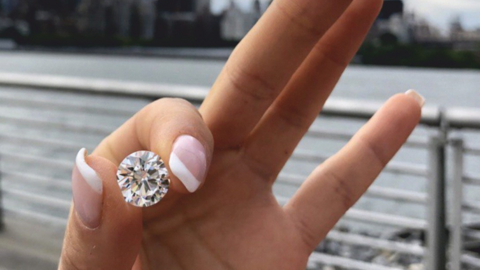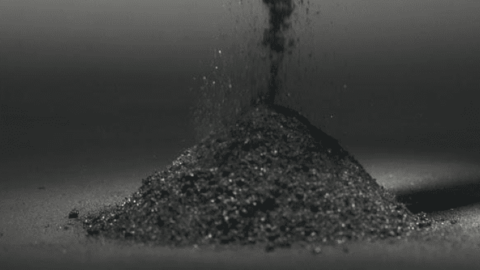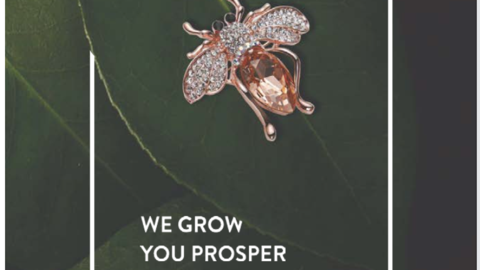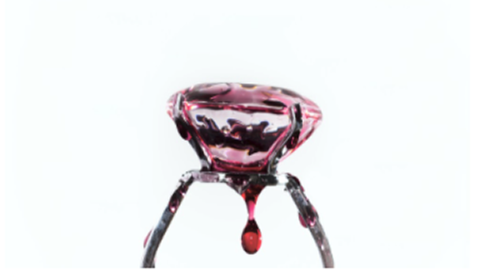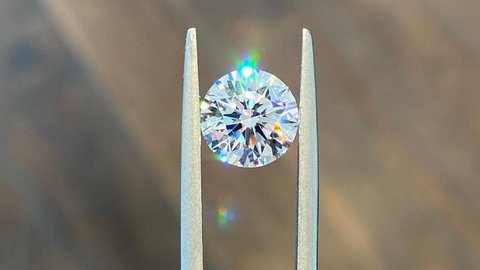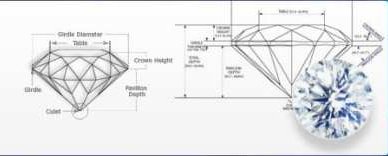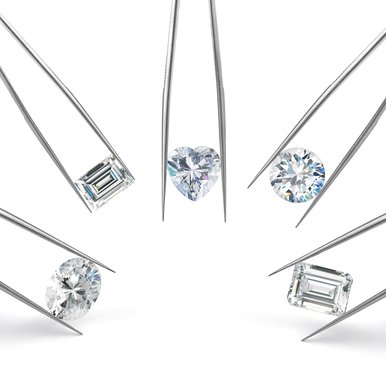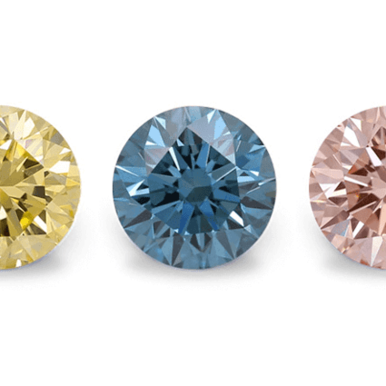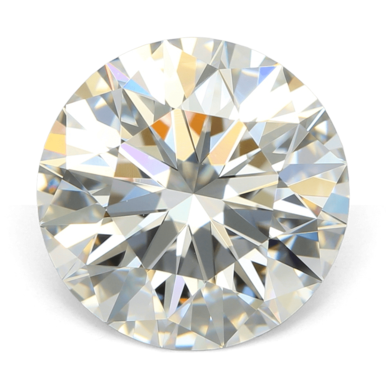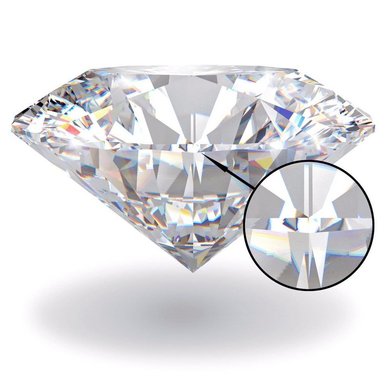Heart Lab-Grown Diamond Rings: Romantic Symbols, Affordable Luxury
Author: Alex K., CMO at Labrilliante Updated: 2025-11-18 Reading Time: 18 minutes
Heart-shaped lab diamonds deliver identical carbon crystal structure and optical properties to mined equivalents while eliminating multi-tier distribution networks that historically added 50-60% retailer markup. CVD production methods yield Type IIa purity with nitrogen impurities below one part per million. This translates to D-F colorless grades at $2,800-$3,500 for 2-carat stones versus $80,000-$110,000 mined pricing—enabling couples to triple carat size or upgrade setting complexity within identical budgets.
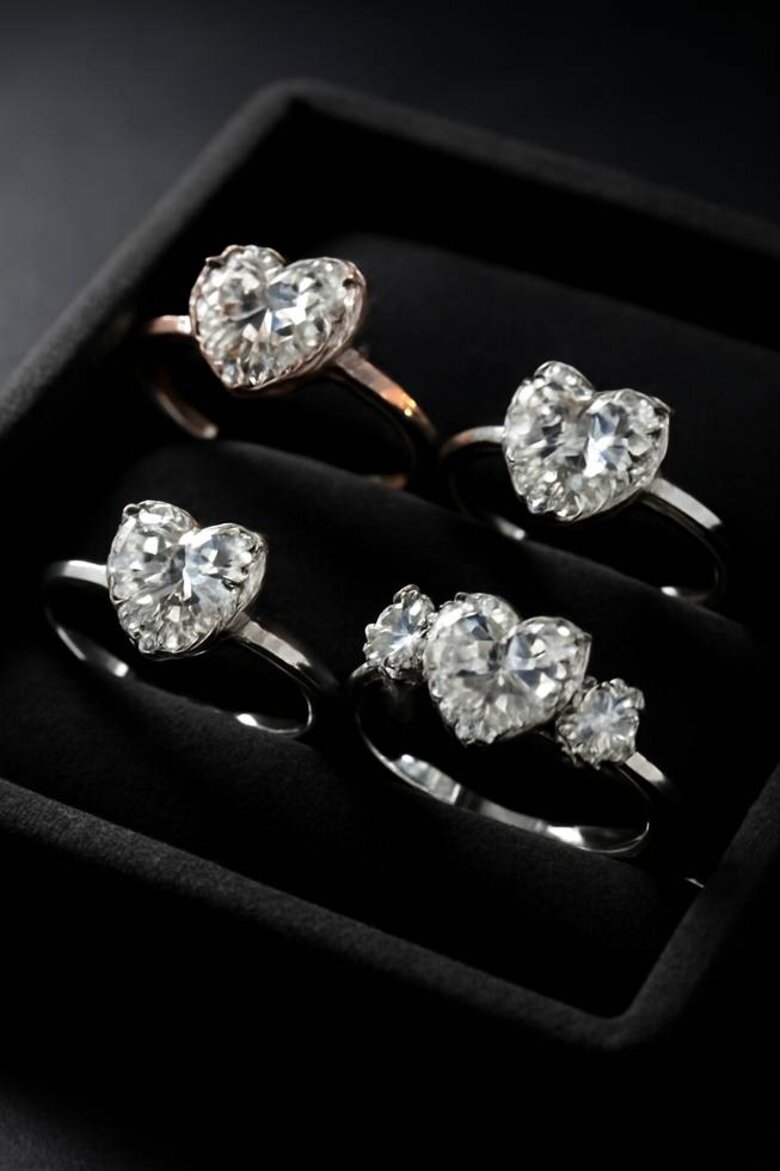
Celebrity proposals spark cultural conversations about what romance looks like in 2025. When engagement ring choices make headlines, couples everywhere begin questioning whether tradition should dictate their most personal decisions. Heart lab-grown diamond rings represent this modern tension—preserving timeless symbolism while rejecting outdated supply chains that prioritize scarcity over substance. This guide reveals how modified brilliant cuts, CVD production transparency, and strategic specification selection create guilt-free luxury. You'll discover the technical precision behind bilateral symmetry, compare setting styles that amplify visual impact, and master budget optimization strategies that professional jewelers use. Whether maximizing carat weight or customizing bespoke designs, the path to authentic expression starts with understanding what actually determines diamond beauty.
The Resale Reality: Why Mined Diamonds Still Dominate Secondary Markets
Critics argue that lab-grown diamonds lack investment value because secondary market pricing remains underdeveloped. They're not entirely wrong. Estate jewelry dealers and pawn shops offer 10-25% of original retail for lab-grown stones versus 30-50% for mined equivalents with GIA certification. This valuation gap reflects established trading networks built over decades around natural diamond commerce. When couples face unexpected financial needs or divorce proceedings requiring asset liquidation, mined stones maintain stronger resale positioning.
The counterargument works if you're buying engagement rings as investment vehicles rather than symbolic expressions of commitment. But here's the practical reality: both mined and lab-grown diamonds lose substantial value the moment they leave retail establishments. That 30-50% recovery rate for mined stones means $50,000 purchases yield $15,000-$25,000 maximum resale—still catastrophic depreciation that makes diamonds poor investment assets regardless of origin. The 60-80% upfront savings on lab-grown stones allows couples to allocate $15,000 toward actual investment vehicles like index funds or real estate down payments while purchasing identical 2-carat hearts that cost mined buyers $50,000.
Most engagement rings never enter secondary markets. They pass through generations as heirlooms or remain on fingers for 50-year marriages. The resale scenario critics emphasize affects fewer than 15% of buyers facing divorce or estate liquidation. For the 85% majority wearing rings daily as relationship symbols rather than portable assets, lab-grown pricing delivers superior value through larger stones, better specifications, and elaborate custom settings—visible benefits enjoyed every day versus theoretical resale value realized almost never.
Heart-Shaped Lab Diamond Engagement Rings: Timeless Symbolism for Modern Romance
Heart-shaped lab-grown diamonds combine 58-facet brilliance with romantic symbolism at 60-80% below mined diamond prices. This distinctive cut demands exceptional precision. The symmetry grade directly impacts whether the two lobes appear balanced and whether the point sits centered beneath the cleft.
[Placeholder Table: Heart Lab-Grown Diamond Rings Comparison: CVD vs HPHT Production Methods - Complete technical specifications, cost differences, and quality characteristics to help buyers choose the optimal growth method for their heart diamond]
| Factor | CVD Heart Diamonds | HPHT Heart Diamonds | Winner for Hearts |
|---|---|---|---|
| Growth Time | 4-8 weeks (0.1-0.5mm/day) | 2-4 weeks (faster growth) | HPHT (Speed) |
| Diamond Type | Type IIa (<1ppm nitrogen) | Type Ib (higher nitrogen) | CVD (Purity) |
| Color Quality | D-F colors achievable | Often needs color treatment | CVD (Consistency) |
| Clarity Potential | VVS1-IF grades common | VS1-VVS2 typical range | CVD (Clarity) |
| Metallic Traces | None (no catalyst used) | Possible from growth chamber | CVD (Clean) |
| Crystal Shape | Square/rectangular plates | Cubic/cubo-octahedral | CVD (Heart yield) |
| Cost Per Carat | $1,400-$1,750 (2ct D VVS2) | $1,200-$1,500 (2ct D VVS2) | HPHT (Price) |
| Best For | Colorless hearts, max clarity | Budget optimization | Depends on priority |
Why Heart Diamonds Represent Forever Love
The heart shape carries universal recognition as love's emblem, dating back to medieval manuscripts where artists stylized ivy leaves and hearts together to symbolize fidelity. Unlike round brilliants optimized purely for light return, the heart cut sacrifices 15-20% of rough diamond weight to preserve its symbolic form. A technical trade-off that mirrors romantic commitment itself.
This modified brilliant cut maintains the traditional 58-facet structure but redistributes them across a geometry requiring master cutters to evaluate each rough crystal for symmetrical lobes and an elegant point. Sound technical? It is. But this precision creates instantly recognizable hearts rather than distorted pears.
Length-to-width ratio determines visual appeal. Industry standards place the ideal ratio between 0.90 and 1.10, with 1.00 representing perfect symmetry. Personal preference varies—some buyers favor slightly wider hearts at 0.95 for fuller appearance, others prefer elongated 1.05 ratios creating slender elegance on smaller fingers.
[Placeholder Image: Heart Diamond Length-to-Width Ratio Visual Guide - Side-by-side comparison showing 0.90, 1.00, and 1.10 ratios on hand models to visualize how proportions affect appearance and finger coverage]
CVD (chemical vapor deposition) and HPHT (high pressure high temperature) both grow atomically identical carbon crystals. CVD typically produces Type IIa diamonds with nitrogen impurities below one part per million. HPHT can introduce metallic traces from growth chamber catalysts. What does this mean? CVD hearts show exceptional clarity with minimal color tint, while HPHT sometimes exhibits slight yellow or brown undertones requiring higher color grades.
The modified brilliant cut requires precise angles. Crown angles should fall between 34-37 degrees, pavilion angles between 40-42 degrees. Deviations cause light to leak through the pavilion or create dead zones in the lobes where brilliance disappears. Table percentage ideally ranges from 53-63%, depth percentage between 58-62% for optimal light performance.
[Placeholder Infographic: Heart Diamond Cut Anatomy and Light Performance - Cross-section diagram showing crown angles (34-37°), pavilion angles (40-42°), table percentage (53-63%), and light path visualization demonstrating optimal vs poor proportions]
Best Heart Engagement Ring Designs for 2025
Heart solitaire settings remain 2025's foundation. A simple band elevates the diamond's symbolic form without competing visual elements. White gold and platinum mountings dominate contemporary preferences at approximately 65% of sales. Rose gold captures 25% among millennials and Gen Z buyers who associate warmer metal with vintage romance. Yellow gold comprises 10%, primarily chosen in the Northeast where traditional preferences persist.
The trade-off? Solitaire settings require prong height sufficient for the stone's depth percentage. Securing a 1.5-2 carat heart demands elevation that some wearers find catches on clothing or appears visually imposing against slim fingers.
[Placeholder Table: Heart Diamond Setting Styles Comparison 2025 - Design options with pricing, durability ratings, and best-suited diamond sizes]
| Setting Style | Price Range | Best Carat Size | Metal Distribution | Visual Impact | Maintenance | Best For |
|---|---|---|---|---|---|---|
| Solitaire | $800-$1,500 | 1.0-2.5ct | 65% white/platinum, 25% rose, 10% yellow | Clean, symbolic focus | Low (annual check) | Traditionalists, shape emphasis |
| Classic Halo | $1,400-$2,800 | 0.75-2.0ct | 70% white/platinum, 30% rose | +20-25% perceived size | Medium (prong security) | Budget maximizers |
| Hidden Halo | $1,200-$2,200 | 1.0-2.0ct | 60% white/platinum, 40% rose | Subtle profile sparkle | Medium (accent security) | Understated luxury |
| Three-Stone | $1,800-$3,500 | 1.0-1.75ct center | 55% white/platinum, 35% rose, 10% yellow | Storytelling symbolism | High (multiple stones) | Sentimental buyers |
| Vintage Halo | $2,000-$4,000 | 1.0-2.0ct | 45% white, 40% rose, 15% yellow | Ornate, heirloom feel | High (milgrain detail) | Vintage aesthetic lovers |
Heart halo settings amplify perceived size. A frame of smaller accent stones surrounds the center diamond, creating luminous glow extending beyond the heart's boundaries. Halos typically add 0.30-0.50 carats of total accent weight. This translates to visual impact equivalent to a center stone 20-25% larger at a fraction of the cost increase.
Hidden halo variants place a thin row of accent diamonds just below the center stone's girdle. Visible only from profile view, this subtle enhancement appeals to buyers seeking customization without ostentatious display.
[Placeholder Image: Heart Halo vs Solitaire Setting Comparison on Hand - Same 1.5ct heart diamond shown in both solitaire and halo settings on the same hand model to demonstrate size perception difference and aesthetic contrast]
Three-stone heart designs position the heart between two side stones. Traditionally representing past, present, and future. Side stone selection creates distinct aesthetics:
- Round brilliants: Maximum sparkle contrast
- Pear shapes: Flowing lines complementing heart curves
- Baguettes: Geometric contrast for architectural sensibilities
The engineering challenge? Balancing total carat weight across three stones. Allocating 60-70% to the center heart with 15-20% to each side stone maintains visual hierarchy. More equal distributions can make the center heart appear diminished.
[Placeholder Mini Case: Budget Optimization Through Strategic Setting Selection - Sarah and Michael's experience choosing a 1.35ct D VS1 heart in a hidden halo setting instead of 1.00ct in a classic halo, saving $1,200 while achieving superior center stone quality and comparable visual impact]
Heartfelt Commitment Through Modified Brilliant Cut Beauty
The heart cut's complexity exceeds most modified brilliants because bilateral symmetry becomes immediately obvious to even untrained eyes. Master cutters evaluate rough diamond crystals for internal grain structure and inclusion placement before committing to a heart shape. Why? A feather fracture positioned where the cleft will form could compromise structural integrity.
Polish grade directly impacts light performance. "Excellent" polish creates microscopically smooth facet surfaces that refract light cleanly. "Good" or "Fair" grades introduce surface irregularities that scatter light and reduce brilliance.
Fluorescence represents another consideration. Diamonds exhibiting "None" fluorescence maintain consistent appearance under all lighting conditions. "Medium" to "Strong" blue fluorescence can cause hazy appearance in direct sunlight despite making diamonds appear whiter under ultraviolet light. Here's the practical reality: fluorescence provides no appearance benefit in colorless D-F diamonds while introducing potential haziness that conflicts with premium positioning.
The culet—the tiny facet at the diamond's pointed bottom—should register as "None" or "Very Small." Even "Small" culets become visible when viewing the heart point-up, creating a distracting dark spot that interrupts romantic symbolism.
[Placeholder Table: Heart Diamond Quality Specifications: Impact on Price and Appearance - Grade-by-grade breakdown showing price differentials and visibility of quality factors]
| Quality Factor | Optimal Grade | Acceptable Grade | Price Difference | Visibility Impact | Recommendation |
|---|---|---|---|---|---|
| Color (White Metal) | D-E | F-G | 15-35% premium for D | Invisible difference in setting | Choose F-G, save 30% |
| Color (Rose Gold) | E-F | G-H | 20-40% premium for E | Warm metal masks tint | Choose G-H, save 40% |
| Clarity | VS1 | VS2-SI1 | 12-25% premium for VS1 | Eye-clean at both grades | Choose VS2, save 20% |
| Polish | Excellent | Very Good | 5-8% premium | Minimal light performance difference | Excellent worth premium |
| Symmetry | Excellent | Very Good | 8-12% premium | Critical for heart shape balance | Excellent essential |
| Fluorescence | None | Faint | 10-15% discount for Medium+ | Potential haziness in D-F colors | None/Faint only |
| Culet | None | Very Small | 3-5% difference | Visible dark spot if larger | None preferred |
Color grade selection between D, E, and F depends on budget allocation and setting metal. D color commands 15-20% premiums over E and 30-35% over F despite differences invisible to most observers in finished jewelry, particularly when set in white gold or platinum. Rose gold settings mask subtle color variations, allowing strategic selection of G-H color grades that deliver 40-50% cost savings while appearing identical when surrounded by the metal's warm tones.
Clarity selection between VS1 and VVS2 grades balances eye-clean appearance with cost efficiency. VS1 diamonds contain minor inclusions visible under 10x magnification but typically invisible to unaided eyes. VVS2 stones exhibit only very slight inclusions that even experienced graders struggle to locate under magnification. The bottom line? VVS2 represents over-specification for most use cases, delivering marginal improvements that few can detect while consuming budget that might better apply to size or setting customization.
[Placeholder Expert Quote: Master Diamond Cutter on Heart Shape Precision Requirements - Industry authority explaining why heart diamonds demand the highest symmetry grades and how proportion deviations affect visual balance]
Carat weight selection between 1.00-2.00 carats represents the sweet spot for heart diamonds. Smaller hearts struggle to display the shape's defining features clearly. Hearts above 2.50 carats face supply constraints as rough crystals suitable for heart cutting become exponentially rarer.
Ethical Lab-Grown Heart Diamonds: Sustainable Luxury Without Compromise
Lab-grown heart diamonds eliminate ethical complications of mining while delivering identical physical properties. Both consist of carbon atoms arranged in cubic crystal structure with Mohs hardness of 10, thermal conductivity near 2200 W/m·K, and refractive index of 2.42. The environmental and humanitarian advantages represent verifiable structural differences in how stones reach market.
Conflict-Free Heart Rings with Full Supply Chain Transparency
Conflict-free certification traditionally verified mined diamonds didn't finance armed conflict. This narrow definition overlooks broader concerns around labor practices, environmental degradation, and community displacement accompanying large-scale mining. Lab-grown diamonds sidestep these considerations entirely.
Their supply chain begins in a manufacturing facility rather than an extraction site. This creates traceability that mining operations with multi-tier rough trading networks cannot replicate.
The Kimberley Process certification scheme covers approximately 99.8% of global diamond production. But it defines "conflict" narrowly as rebel movements fighting legitimate governments. This framework excludes human rights abuses by governments themselves, environmental damage, or labor exploitation. Lab-grown diamonds render these certification schemes obsolete by eliminating the mining phase where such violations occur.
The transparency preference among sustainability-driven buyers extends beyond the diamond to setting metals. Recycled gold and platinum deliver identical properties to newly mined metals while avoiding the 20 tons of earth displacement required to extract a single ounce of gold through conventional mining. What's the takeaway? The combination of lab-grown center stones with recycled metal settings creates guilt-free luxury addressing the full environmental footprint.
[Placeholder Infographic: Lab-Grown vs Mined Diamond Supply Chain Transparency - Side-by-side flow charts showing 3-step traceable lab process versus 12-step mining supply chain with verification points, intermediaries, and ethical risk zones highlighted]
Eco-Friendly CVD and HPHT Production Processes
CVD grows diamonds by introducing carbon-rich gases into a vacuum chamber. Microwave energy breaks molecular bonds, allowing carbon atoms to deposit layer by layer onto a thin diamond seed plate. Growth rates typically reach 0.1-0.5mm per day depending on chamber design. This produces rough crystals suitable for cutting within 4-8 weeks.
The CVD process operates at relatively modest pressures near one atmosphere and temperatures between 700-900°C. Let's break this down: it contrasts sharply with HPHT's recreation of Earth's mantle conditions.
HPHT employs massive hydraulic presses with pressures exceeding 50,000 atmospheres and temperatures above 1,400°C. Growth occurs radially in HPHT chambers, producing cubic or cubo-octahedral crystal shapes. CVD creates square or rectangular plates. These growth habits influence how efficiently rough can be cut into specific shapes—CVD plates lend themselves more naturally to emerald cuts, while HPHT cubes favor round brilliants.
Heart shapes can derive from either process with careful planning. CVD's predictable growth geometry sometimes allows better yield optimization.
[Placeholder Image: CVD vs HPHT Diamond Growth Process Visualization - Split-screen technical illustration showing CVD vacuum chamber with layered growth on seed plate versus HPHT hydraulic press with radial crystal formation, including temperature and pressure specifications]
Energy consumption represents lab-grown diamonds' primary environmental consideration. CVD and HPHT both require significant electrical inputs—production energy estimates range from 250-750 kWh per carat depending on process efficiency, equipment age, and growth parameters.
How does this translate? This energy demand compares favorably to diamond mining when accounting for diesel fuel for excavation equipment, explosives manufacturing, ore processing, water pumping, and transportation across multi-continental supply chains. But absolute sustainability requires renewable energy sourcing.
[Placeholder Table: Environmental Impact Comparison: Lab-Grown vs Mined Heart Diamonds - Quantified data on energy consumption, water usage, land disruption, and carbon emissions per carat]
| Environmental Factor | Lab-Grown (CVD) | Lab-Grown (HPHT) | Mined Diamond | Lab Advantage |
|---|---|---|---|---|
| Energy (kWh/carat) | 250-400 | 450-750 | 538+ (mining + transport) | 30-50% reduction |
| Water (gallons/carat) | 18-25 | 25-35 | 126 | 80% reduction |
| Land Disruption (sq ft) | 0 | 0 | 250 (waste rock included) | 100% elimination |
| Carbon Emissions (kg CO2) | 60-120 (grid power) | 100-160 | 160-200 | 25-60% reduction |
| Supply Chain Stages | 3 (grow, cut, certify) | 3 (grow, cut, certify) | 12+ (mine to retail) | 75% fewer intermediaries |
| Human Displacement | 0 people | 0 people | ~1.5M globally in mining | 100% elimination |
Conscious Luxury for Guilt-Free Proposals
The conscious luxury movement represents buyers refusing to accept the false choice between ethical sourcing and premium quality. Traditional luxury marketing positioned scarcity and exclusivity as inherent values. Lab-grown diamonds invert this framework by demonstrating that identical chemical and optical properties can exist without the artificial scarcity mining supply chains maintain.
The 60-80% savings relative to mined equivalents derives not from inferior quality but from eliminating multi-tier distribution networks. Mining, rough trading, and distribution add costs without adding value to the final product.
Value-conscious millennials and Gen Z buyers approach engagement ring purchases with research intensity previous generations reserved for home or automobile buying. These smart spenders compare specifications across vendors, verify certification independently through IGI and GIA online databases, and reject marketing narratives that can't withstand technical scrutiny.
Engagement rings function as meaningful choice expressions where couples define relationship values through purchasing decisions. Selecting a heart-shaped lab-grown diamond signals prioritization of romantic symbolism and authentic love story creation over conformity to prescribed traditions.
The shape choice itself represents unique expression. Heart diamonds comprise a small fraction of engagement ring sales compared to rounds at 60%, ovals at 15%, and princess cuts at 10%. This rarity creates conversational value where the ring prompts questions and allows wearers to share the deliberate thought process behind their selection.
[Placeholder Expert Quote: Sustainability Consultant on Conscious Luxury Diamond Purchasing - Third-party environmental specialist explaining how lab-grown diamonds with renewable energy sourcing achieve carbon-neutral luxury status]
Affordable Heart Lab Diamond Rings: Substantial Savings with Designer Quality
Lab-grown heart diamonds cost 60-80% less than mined equivalents with identical specifications. Significant savings. A 2.00-carat D color VVS2 heart diamond costs approximately $2,800-$3,500 from lab-grown manufacturers versus $80,000-$110,000 for mined equivalents.
[Placeholder Table: Heart Lab Diamond Price Ranges by Carat and Quality Tier - Complete pricing matrix showing cost progression across sizes and specification levels to guide budget allocation]
| Carat Weight | Budget Tier (G-H, VS2-SI1) | Premium Tier (E-F, VS1-VVS2) | Luxury Tier (D-E, VVS2-VVS1) | Mined Equivalent (Premium Tier) | Savings vs Mined |
|---|---|---|---|---|---|
| 0.75ct | $600-$900 | $900-$1,300 | $1,200-$1,700 | $5,500-$7,500 | 80-85% |
| 1.00ct | $900-$1,300 | $1,300-$1,800 | $1,700-$2,400 | $9,000-$12,500 | 80-85% |
| 1.50ct | $1,400-$2,000 | $2,000-$2,800 | $2,600-$3,600 | $18,000-$25,000 | 85-88% |
| 2.00ct | $2,000-$2,800 | $2,800-$3,800 | $3,600-$5,000 | $35,000-$48,000 | 88-90% |
| 2.50ct | $2,800-$3,900 | $3,900-$5,400 | $5,200-$7,200 | $55,000-$75,000 | 90-92% |
| 3.00ct | $3,800-$5,200 | $5,200-$7,200 | $7,000-$9,800 | $85,000-$115,000 | 92-93% |
Mining operations incur extraction costs including equipment, labor, land rights, environmental compliance, and ore processing. Tons of earth yield individual diamonds. After extraction, rough diamonds pass through sorting facilities, rough trading markets, cutting centers, polished trading networks, wholesalers, and retail jewelers. Each intermediary adds markup that compounds by transaction's end.
Lab-grown diamonds bypass the mining phase entirely. Costs primarily involve equipment amortization, energy consumption, technician labor, and cutting. Direct-to-consumer manufacturers eliminate the wholesaler and retailer markups that historically comprised 50-60% of mined diamond retail prices.
The $1,500-$3,000 range represents the largest volume segment for heart lab diamond engagement rings. This price point typically delivers 1.00-1.50 carat stones in E-G color and VS1-VS2 clarity with excellent cut quality in white or rose gold settings. Affordable luxury that remains accessible to median household income buyers without requiring financing.
The $3,000-$5,000 premium segment allows either larger stones approaching 2.00 carats or top specifications around 1.50 carats with D-E color and VVS2-VVS1 clarity. Plus more elaborate settings like halos or three-stone designs with premium side stones.
[Placeholder Mini Case: Carat Size Maximization Through Lab-Grown Savings - Jennifer and Tom's decision to allocate their $5,000 budget to a 2.25ct E VS1 lab heart instead of 0.75ct F VS1 mined heart, tripling their diamond size while maintaining premium quality specifications and adding custom rose gold halo setting within the same total budget]
The $5,000-$8,000 luxury tier reaches 2.00-2.50 carats with exceptional specifications. This demonstrates how lab-grown pricing makes previously unattainable sizes realistic for budget-friendly luxury positioning.
Trade-offs do exist. Lab-grown diamonds lack the geological rarity that some buyers value as inherent to romantic symbolism. This perspective treats scarcity itself as valuable rather than focusing on the physical and optical properties that determine diamond beauty. The counterargument? Artificially limiting supply through mining production controls creates economic rather than absolute scarcity. Enough carbon exists underground to produce millions more carats annually if extraction were economically viable.
Couples must evaluate which philosophical framework aligns with their values: rarity through production limitations or accessibility through technological advancement.
IGI Certified Heart Diamonds: Grading Reports and Authenticity Guarantees
IGI certified grading reports provide independent documentation of diamond characteristics including the four Cs—carat weight, color grade, clarity grade, and cut quality. Plus additional specifications like fluorescence, polish, symmetry, proportions, and detailed plotting of internal and external characteristics.
The International Gemological Institute operates as one of three primary diamond certification authorities alongside GIA (Gemological Institute of America) and GCAL. Each maintains slightly different grading standards and reporting formats that create market preferences across regions and price segments.
IGI has emerged as the dominant certification body for lab-grown diamonds, grading approximately 60-65% of laboratory-grown stones versus 25-30% for GIA. This market position reflects IGI's early adoption of lab-grown grading protocols and competitive turnaround times rather than technical superiority.
[Placeholder Table: IGI vs GIA vs GCAL Certification Comparison for Lab-Grown Hearts - Authority comparison showing grading consistency, market acceptance, turnaround times, and pricing implications]
| Certification Body | Market Share (Lab-Grown) | Grading Consistency | Report Turnaround | Cost to Certify | Resale Value Impact | Best For |
|---|---|---|---|---|---|---|
| IGI | 60-65% | Slightly lenient (+1 grade) | 5-7 business days | $75-$125 | Strong lab-grown acceptance | Lab-grown buyers, faster delivery |
| GIA | 25-30% | Strictest standards (baseline) | 10-15 business days | $100-$180 | Highest traditional market value | Maximum resale value, traditionalists |
| GCAL | 5-8% | Strict (GIA equivalent) | 7-10 business days | $125-$200 | Strong with educated buyers | Technical buyers, light performance focus |
| No Certification | 2-5% | No verification | Immediate | $0 | 20-30% value reduction | Budget buyers (not recommended) |
GIA maintains the strictest color and clarity grading standards with the most conservative grade assignments. This makes GIA certificates more valuable in the mined diamond market where premium pricing justifies the added cost and stricter grading. IGI and GIA use identical methodology for physical measurements and technical assessments, but grading thresholds for subjective categories like color boundaries and clarity plotting can vary by approximately one grade between laboratories.
The certification verification systems allow consumers to access full grading reports online by entering certificate numbers. This provides authenticity guarantee that confirms purchased diamonds match certified specifications. These databases include high-resolution photographs showing actual diamond appearance and detailed proportion diagrams with table percentage, depth percentage, crown angles, pavilion angles, and symmetry assessments.
[Placeholder Image: Sample IGI Heart Diamond Grading Report with Key Sections Annotated - Actual grading report with callouts identifying certificate number, 4Cs grades, proportion diagram, plotting diagram, and verification methods to educate buyers on reading certification]
Grading report formats differ between laboratories but all contain core information:
- Certificate number for verification reference
- Carat weight measured to 0.01ct precision
- Color grade on the D-Z scale where D represents colorless
- Clarity grade from Flawless through VVS1, VVS2, VS1, VS2, SI1, SI2 to I1-I3
- Cut grade for shapes where standardized proportions exist
Hearts receive symmetry grade assessments but typically not comprehensive cut grades as no industry consensus exists for ideal heart proportions the way Tolkowsky's calculations established standards for round brilliants.
The most valuable grading report information extends beyond summary grades to actual measurements and plotting diagrams. A 1.50-carat heart diamond's measurements might read 8.15 x 7.63 x 4.82mm. This reveals the length-to-width ratio of 1.07 (slightly elongated) and depth of 4.82mm that converts to 63.1% depth percentage. Crown height, pavilion depth, girdle thickness, and culet size appear as percentages or descriptive terms, allowing technical evaluation of proportions that impact light performance.
The plotting diagram maps inclusion positions and types—crystals, clouds, feathers, pinpoints, cavities, or other characteristics that determined the final clarity grade. This documentation allows buyers to verify that centrally located inclusions don't appear visible through the table or positioned near the point where mechanical stress concentrates.
[Placeholder Expert Quote: IGI Gemologist on Heart Diamond Symmetry Grading - Certification authority explaining the specific symmetry requirements for heart shapes and how bilateral balance affects grade assignments from Excellent to Poor]
The authenticity guarantee extends beyond initial certification to include lifetime warranty provisions covering manufacturing defects, setting integrity, and prong security. Laboratory-grown diamonds possess identical hardness and durability to mined stones—both rate 10 on Mohs hardness scale and exhibit fracture toughness around 7-10 MPa√m. But settings represent potential failure points where improper prong placement or inadequate metal thickness creates loss risk.
Warranties typically cover setting repairs and stone replacement if loss occurs due to setting failure. This excludes damage from obvious abuse or wear patterns from failure to perform recommended annual maintenance inspections.
Custom Heart Diamond Settings: Bespoke Designs from Solitaire to Halo
Custom heart diamond settings transform standardized jewelry into personalized expressions reflecting individual style preferences and relationship narratives. The bespoke design process typically begins with style consultations where customers describe aesthetic preferences, review portfolio examples, and identify specific design elements they want incorporated.
The technical customization process involves creating CAD (computer-aided design) renderings. These show three-dimensional models from multiple angles, allowing customers to visualize proportions, evaluate design flow, and request modifications before manufacturing begins. Modern CAD systems couple to CNC milling equipment and 3D printers that convert digital designs to physical masters with 0.05mm tolerances. This creates precise execution that hand-fabrication cannot consistently replicate.
[Placeholder Image: CAD Design to Final Product: Custom Heart Halo Setting Transformation - Four-stage visual progression showing initial CAD rendering, 3D printed wax model, metal casting, and final finished ring with same 1.75ct heart diamond to demonstrate custom design process accuracy]
Solitaire customization focuses on prong configuration, band width and profile, and metal selection. Standard six-prong settings secure heart diamonds reliably while maintaining openness that allows light to enter from sides and beneath. Some customers prefer four-prong settings that position prongs at the lobes and point, creating cleaner appearance at the cost of slightly reduced security.
Band width typically ranges from 1.5-2.5mm for proportional aesthetics. Narrower bands create delicate appearance that suits smaller hands. Wider bands provide bold presence and structural stability for larger stones. The band profile can be rounded comfort-fit for all-day wearability, flat for contemporary aesthetics, or knife-edge for architectural geometry.
Halo customization introduces variables around accent stone size, halo shape matching, gap spacing, and accent stone quality specifications. Typical halo diamonds range from 0.01-0.03 carats each with 28-34 stones surrounding the center heart, totaling 0.35-0.65 carats of accent weight.
The halo outline can either follow the heart's curves exactly, creating organic flow, or employ geometric circle or cushion halos that provide shape contrast. Gap spacing between center and halo affects perceived integration. Tighter gaps read as unified design where halo extends the center stone. Wider gaps create distinct separation that emphasizes the center heart as primary focus.
[Placeholder Table: Custom Setting Elements and Cost Impact Analysis - Customization options with price additions and design timeline implications]
| Customization Element | Standard Option | Custom Upgrade | Cost Addition | Production Time | Visual Impact |
|---|---|---|---|---|---|
| Prong Configuration | 6-prong | 4-prong custom placement | $150-$300 | +5 days | Cleaner sightlines, slightly less secure |
| Band Width | 2.0mm standard | 1.5mm delicate or 2.5mm bold | $100-$250 | +3 days | Proportion optimization for hand size |
| Band Profile | Rounded comfort-fit | Knife-edge architectural | $200-$400 | +7 days | Contemporary geometric aesthetic |
| Halo Shape | Round follow-outline | Custom cushion contrast halo | $400-$700 | +10 days | Unique shape interplay |
| Metal Mixing | Single metal | Two-tone (band + prongs) | $300-$600 | +7 days | Vintage-modern hybrid style |
| Accent Stones | Standard lab melee | Premium lab hearts/pears | $500-$1,200 | +14 days | Thematic unity, premium sparkle |
| Engraving | None | Custom inside band engraving | $75-$150 | +2 days | Hidden personal message |
| Filigree Detail | Clean modern | Vintage scrollwork | $400-$800 | +12 days | Ornate heirloom appearance |
Three-stone customization requires balancing center and side stone sizes, selecting side stone shapes, and determining spacing. The traditional formula allocates 60-70% of total carat weight to the center stone, leaving 15-20% for each side stone. A 1.50-carat center heart might pair with 0.40-0.50 carat side stones totaling 2.30-2.50 carats across all three.
Side stone shapes create different aesthetic narratives:
- Round brilliants: Maximum sparkle and traditional symmetry
- Pears positioned point-out: Flowing lines that extend horizontal presence
- Emerald cuts: Geometric contrast with step-cut faceting
- Matching smaller hearts: Thematic unity
Personalized engraving adds hidden messages inside the band. Initials, dates, coordinates, or brief phrases that carry meaning visible only to the wearer. Laser engraving technologies now achieve 0.02mm line widths with depth control that prevents compromising structural integrity. This allows detailed text and even small images to be permanently inscribed.
Metal mixing introduces additional customization where primary settings use one metal while accents or inlays employ another. Rose gold bands with white gold prongs create two-tone appearance that frames the diamond while providing warm band color. Platinum settings with yellow gold filigree details callback to vintage aesthetics while maintaining contemporary proportions.
[Placeholder Infographic: Bespoke Heart Ring Design Decision Tree - Step-by-step visual flowchart guiding buyers through sequential customization choices from metal selection → setting style → accent details → personalization, showing how decisions build complexity progressively and impact final pricing]
The design-your-own process empowers customers to specify every element. This freedom creates decision paralysis without expert guidance. What matters most? Structured customization frameworks where customers make sequential decisions—first metal type, then setting style, followed by accent details, and finally personalization elements. This builds complexity progressively rather than presenting 50 simultaneous choices that overwhelm and delay decisions.
The one-of-a-kind heart engagement rings that emerge from these processes reflect authentic personal expression that mass-produced inventory cannot replicate. The ring embodies the couple's specific values and aesthetics rather than jeweler's production efficiency.
Why Lab-Grown Hearts Represent Romance Without Compromise
Heart-shaped lab diamonds combine universal love symbolism with verifiable supply chain transparency and 60-80% cost savings that transform engagement ring possibilities. The modified brilliant cut's 58-facet structure delivers identical light performance to mined equivalents while eliminating ethical complications of extraction-based commerce. Strategic specification selection—F-G color in white metals, VS2 clarity for eye-clean appearance, excellent symmetry for bilateral balance—optimizes budget allocation toward size and setting customization that creates daily visual impact.
Design Your Forever Ring Today
Labrilliante's expert consultants guide you through heart diamond selection with IGI-certified stones, CAD design visualization, and bespoke setting creation from solitaires to vintage halos. Book your complimentary consultation now to explore 1.5-2.5 carat hearts in premium E-F VS1 specifications, compare three-stone configurations with pear side stones, and preview custom renderings before production begins. Your authentic love story deserves a ring as unique as your commitment—let's create it together.
Frequently Asked Questions
The industry standard places the ideal ratio between 0.90 and 1.10, with 1.00 representing perfect symmetry. Personal preference varies—some buyers favor slightly wider hearts at 0.95 for fuller appearance, while others prefer elongated 1.05 ratios that create slender elegance on smaller fingers.
Lab-grown heart diamonds cost 60-80% less than mined equivalents with identical specifications. For example, a 2.00-carat D color VVS2 heart diamond costs approximately $2,800-$3,500 lab-grown versus $80,000-$110,000 for mined, representing savings of over 90% at larger sizes.
IGI grades approximately 60-65% of laboratory-grown stones due to early adoption of lab-grown grading protocols and faster turnaround times (5-7 business days versus GIA's 10-15 days). While GIA maintains slightly stricter grading standards, IGI provides strong market acceptance for lab-grown diamonds at lower certification costs ($75-$125 versus $100-$180).
CVD creates Type IIa diamonds with nitrogen impurities below one part per million, yielding superior D-F colorless grades and VVS1-IF clarity more consistently than HPHT. The square/rectangular crystal plates from CVD growth also provide better rough material yield when cutting heart shapes compared to HPHT's cubic formations.
Lab-grown diamonds offer 10-25% resale value versus 30-50% for mined stones, but both experience catastrophic depreciation from retail prices. Since fewer than 15% of engagement rings ever enter secondary markets, the 60-80% upfront savings on lab-grown stones provides superior value through larger sizes, better specifications, and elaborate settings enjoyed daily rather than theoretical resale value realized almost never.
Strategic optimization involves selecting F-G color (saves 30-40% versus D-E with invisible difference in white metal settings), VS2 clarity (eye-clean like VS1 but 20% less expensive), and allocating savings toward carat size. A $5,000 budget can purchase either a 1.00ct D VVS1 or a 2.25ct E VS1—tripling size while maintaining premium quality creates greater visual impact.
Excellent symmetry grade is essential for bilateral balance that makes or breaks heart shape appeal. Crown angles should fall between 34-37 degrees, pavilion angles between 40-42 degrees, table percentage 53-63%, and depth percentage 58-62% for optimal light return. Polish grade should be Excellent rather than Good/Fair to ensure facet surfaces refract light cleanly without scattering.
Choose halos to maximize perceived size (adds 20-25% visual impact) when working with 0.75-1.5ct centers and tighter budgets—the accent stones create luminous glow equivalent to a 25% larger center stone. Select solitaires for 1.5ct+ hearts when shape emphasis is priority, or when preferring clean lines without competing visual elements that let the heart's symbolic form dominate.


